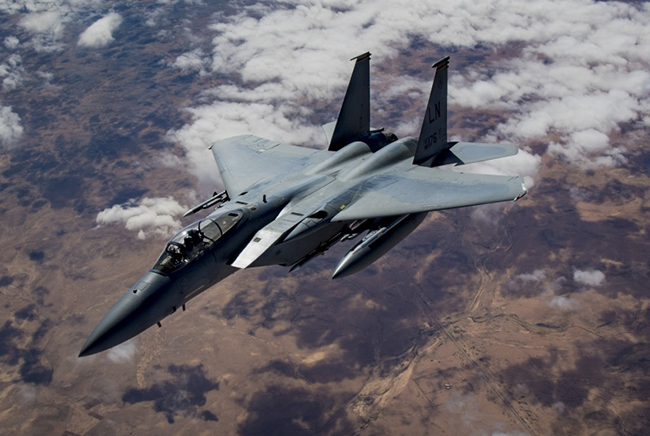
An Air Force F-15C flies in support of Combined Joint Task Force – Operation Inherent Resolve on Feb. 11, 2019. Air Force photo by SSgt. Clayton Cupit.
The proposed purchase of F-15EX “advanced Eagles” will allow the Air Force to avoid having to ground F-15C squadrons as the aircraft age out without any new construction or downtime, Air Force Secretary Heather Wilson said Wednesday.
The service’s fiscal 2020 budget proposal includes about $1 billion for eight F-15EXs, the start of a multi-year buy that includes 80 of the EX-variants over the next five years toward a possible maximum buy of 144 aircraft. Wilson, speaking Wednesday at the Heritage Foundation in Washington, D.C., offered a defense of the plan that weeks ago she said was not the Air Force’s wish.
Analysis showed that within the next eight to 10 years, the Air Force’s aging F-15C fleet “is not going to make it,” so the Pentagon needed to find a way to keep the service’s capacity high “for the 2030s and beyond, for all the missions we have to cover.”
“That was the nature of the analysis and the decision, as we went through the budget development with the money we have available,” she said, adding the discussion focused on, “How do we keep our capacity and expand our capability?”
With foreign companies buying new F-15s, such as the F-15QA for Qatar and the F-15SA for Saudi Arabia, Boeing’s F-15 line is still open. Also, because of similarities between the F-15C and the planned F-15EX, the aircraft could be brought into the service “without any MILCON, without much downtime at all.” There won’t be a big need to retrain maintainers, and there will be minimal change to ground equipment, she said.
“It was: What do we think we can do, given the funding available, to not end up having to ground squadrons of F-15Cs with nothing to replace ‘em,” Wilson said.
Chairman of the Joint Chiefs of Staff Gen. Joseph Dunford, testifying Tuesday at the House Armed Services Committee, said the department also considered the potential impact on the industrial base, noting that helped to drive the decision to buy the Boeing-made F-15EX. A senior defense official told reporters last week that “maintaining diversity” in suppliers as the military moves toward a sixth-generation fighter “is going to be critical.” While the comments didn’t mention F-22 supplier Lockheed Martin by name, the official said it is “desirable” to keep big contractors healthy.
While the Air Force is still focused on the F-35, Lockheed’s inability to reduce sustainment costs was a key factor in the F-15 decision, Dunford said.
“If you could buy all the F-35s, you might do that. This, again, was looking out, over time, at the resources that would be available. And there’s not much different in the procurement cost,” he said. “But, there’s about a 50 percent difference in the operations and sustainment cost between the F-15 and the F-35. And the F-15 also has a pretty significant shelf life available as well.”